Camp Tarawa USOs
By Fred Greguras
I have recently attended several reunions of Iwo Jima veterans who trained at Camp Tarawa on the Big Island of Hawaii. The highlight was exploring the Big Island with them during the Fifth Marine Division Association (FMDA) reunion in October, 2017. In listening to the vets, the two most common memories I heard were about the graciousness of the people of the Big Island and the relief they felt when the word came down that the Japanese had surrendered after the two atomic bombs were dropped so they wouldn’t have to invade the mainland of Japan which is what they were training to do. One of the places the Marines remembered liking on the Big Island were the United Service Organizations (USO) so I thought it would be interesting to try to identify where they were and what happened to them.
The United Service Organizations offered a touch of home for servicemen during WWII through activities and events such as dances, movies, music and a place to write a letter home or grab a free cup of coffee and a sandwich. Founded in 1941, the USO was created at the request of President Franklin Roosevelt. His call brought six organizations (YMCA, YWCA, Salvation Army, National Catholic Community Service, National Travelers Aid Association and the National Jewish Welfare Board) together to form a private, non-profit organization to provide morale, entertainment and other support services for U.S. military personnel away from home.
The Big Island USO was organized on September 14, 1941 and USO facilities were opened throughout the island beginning in early 1942 in buildings such as former stores, public libraries, church and school buildings, community halls and other places. Decorations and furnishings were often donated by the public. During the early part of WWII, the Big Island USOs served the Army units on the island and sailors at the Hilo Naval Air Station (NAS). The arrival of the 2nd Marine Division and establishment of Camp Tarawa at Kamuela (Waimea) in December, 1943 dramatically changed the demand for USO services. Over 50,000 Marines trained on the Big Island during the period between December, 1943 and August, 1945. After the 2nd Marine Division left for the Tinian and Saipan campaigns, the 5th Marine Division used Camp Tarawa both before and after the assault on Iwo Jima. The 5th Division left for occupation duty in Japan in late August 1945 after the war ended and Camp Tarawa was closed in November 1945.
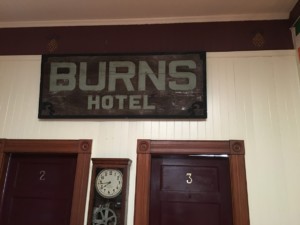
Burns Hotel, Hilo. Photo Fred Greguras.
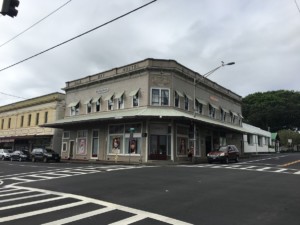
Big Island USO HQ: Burns Building, Hilo, Hawaii Island. Photo: Fred Greguras.
The Marines were at four locations: the main camp was at Waimea; artillery camp at Pohakuloa; amtrac camp at Hapuna Beach and the division rear at Camp Banyan at the port facilities in Hilo. The liberty destination closest to main side at Waimea was Honoka’a, about 15 miles east. Hilo was a very long trek from main side (about 55 miles), Kona was about 40 miles and Hawi about 22 miles. Hilo was the most important city on the Big Island during WWII and was the headquarters for the USO.
Waimea
The busiest and most popular USO was at Barbara (Kahilu) Hall (now Parker School) at main side Camp Tarawa in Waimea. It was the site of dances with live music played by famous orchestras, entertainment by big-name stars and other recreational activities. Barbara Hall was built in 1915 as a place for rest and relaxation for Parker Ranch employees and later became the community hall. The building is still there on the north side of Lindsey Road across from the county park. There is a memorial to its USO service in front of the building. The building was expanded during WWII to include the current theater wing where a school and community program was held to commemorate the return of Iwo Jima vets at the FMDA reunion in October, 2017. The vets were greeted by Parker School students as they entered the theater.
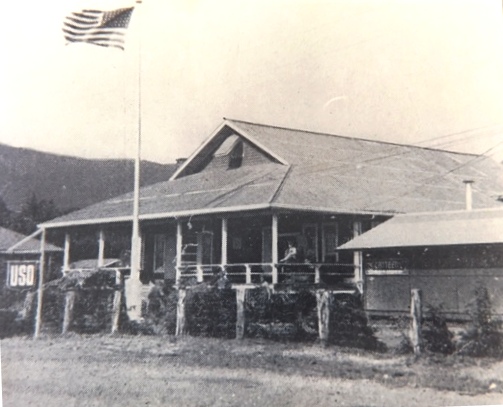
Parker School, WWII era & now. Photo credit: Lyman Museum & Fred Greguras.
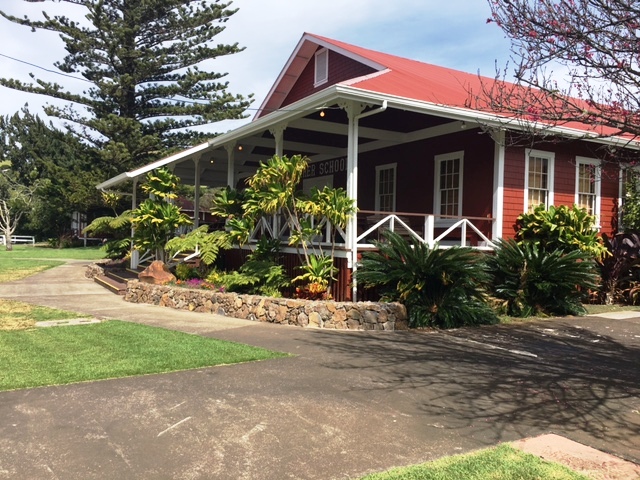
Hilo
Wayne Cockrell was the director of Big Island USOs and established his initial headquarters at the Hilo Chamber of Commerce office in early February, 1942. By early March, 1942, the Big Island USO had its headquarters on the first floor of the Burns Building at the corner of Waianuenue and Keawe Street. The headquarters had reading and writing rooms for the servicemen. The Burns Building is still there with various businesses on the ground level and the Hilo Bay Hostel upstairs where the Burns Hotel was once located.
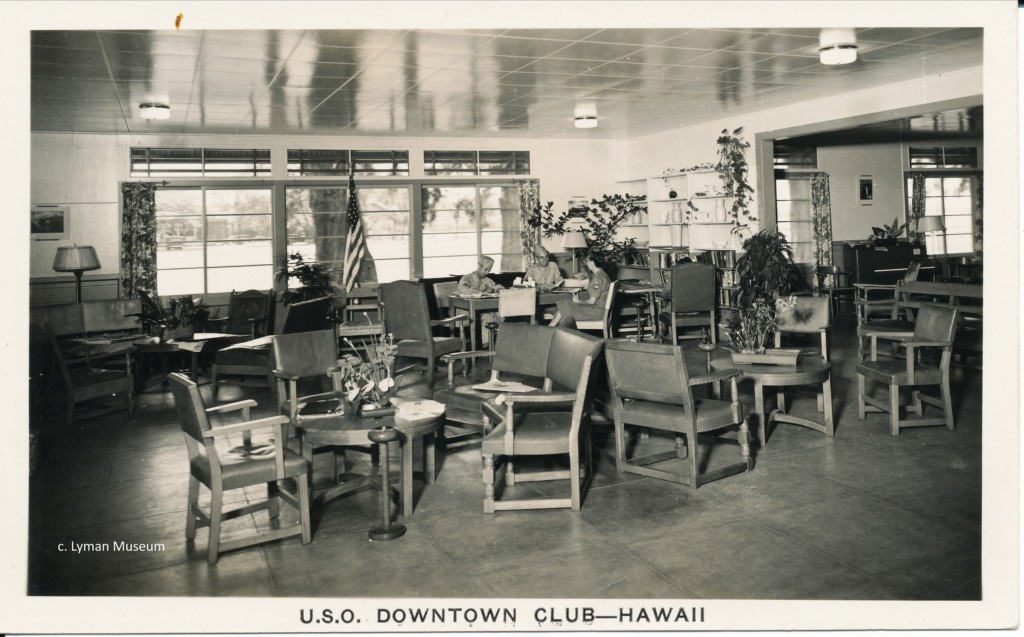
Hilo Downtown USO Club interior, WWII period. Credit: Lyman Museum.
There were several USO clubs and other USO facilities in Hilo. Marines would recognize many of the buildings on the west side along Kamehameha Avenue in the downtown area of Hilo. Most of the makai (ocean) side buildings were washed away in the 1946 and 1960 tsunamis. The Downtown USO club was at 459 Kamehameha (makai side) according to Sanborn maps. This was near the east side of Mo’oheau Park, next door to the west of the American Factors (Amfac) warehouse known as the Cow Palace. This club is also known as the Mo’oheau Park Club. It was washed away in the 1946 tsunami along with many other buildings. The site of this USO is a recreation field on Kamehameha across from the HELE gas station at Ponahawai Street.
The Mokuola USO was a very popular recreation facility at Coconut Island to the northwest of Banyan Drive. Swimming, diving, boating and other water sports were available and dances were also held there. There was a regularly scheduled bus service from the Downtown USO to the Mokuola USO. While the USO facilities and bridge were swept away by the 1946 Tsunami, Coconut Island continues to be a popular park today that is easily accessible by a walking bridge.
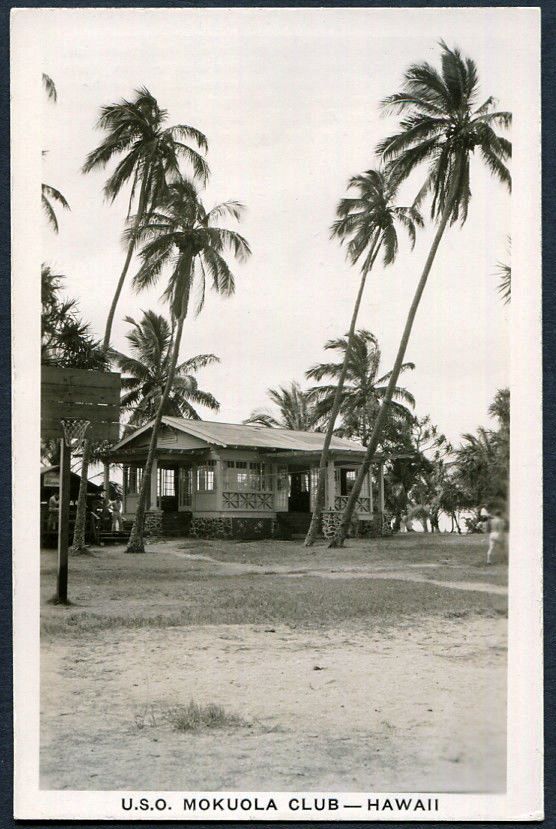
Mokuola USO Club. Photo credit: Lyman Museum.

In May, 1942, Father Rev. Martin Dornbusch offered the use of the St. Joseph Catholic Church Parish Hall for use as a USO. This was the Haili Street or Center USO. This club was opened by early June, 1942. The first level of the parish hall was used as club rooms and the second floor as the recreation and dance hall. St. Joseph’s Church is at the corner of Haili and Kapiolani Streets about four blocks up the hill from Kamehameha. The parish hall was on the makai side of the church near the church tower. It was torn down in the early 1990s. There was a fire (set by an arsonist) on September 14, 1943 that damaged the parish hall USO. A Haili Street USO was open until December, 1945 but it’s not clear whether the parish hall was repaired or if a nearby building was used as the USO after the fire.
There were two USO hostels in Hilo as of July, 1945; one at 614 Kilauea Ave. and the other at 55 Manono Street. The hostels were mostly just cots, sheets, pillows, blankets and towels. The building at 614 Kilauea Ave. is still there and is used for various types of offices. I believe the other USO hostel was in the gymnasium at a Japanese Buddhist Temple complex which was at 55 Manono according to Sanborn maps. The Manono buildings were swept away in the 1946 tsunami. The site is currently a recreation area.
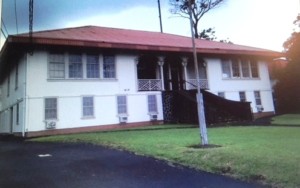
614 Kilauea USO Hostel then and now. Photo credit: Gladys Suzuki.
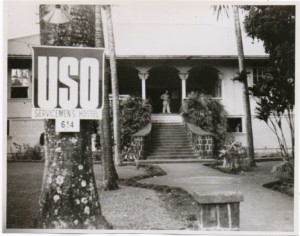
In March, 1943 the Yamatoza Theater on Mamo Street was donated to the USO and was named the USO Playhouse. Drama, music, lectures and other entertainment was provided there. The theater had a grand opening performance on March 12, 1943. This theater was located on the south side of Mamo Street, west of Punahoa Street, about a block and a half west of Kamehameha. The theater was destroyed by the 1960 tsunami. The site is in the present day Hilo farmers market. USO performers stayed at the Naniloa Hotel on Banyan Drive where the Hilton Doubletree is now located.
Honoka’a
The Parker Ranch management prohibited liquor in Waimea so the Marines from Camp Tarawa went to the bars and clubs in Honoka’a to blow off steam. The Marines visited frequently since it was the closest town to Waimea. Many of the buildings on the Honoka’a main street, Mamane, would still be recognizable by Camp Tarawa Marines. The store names have changed but many of the WWII era buildings are still there. Landmarks include the People’s Theater, the Botelho Building, Andrade Building and the Hotel Honoka’a Club. The Historic Honoka’a Town Map published by the Historic Honoka’a Town Project is an excellent guide.

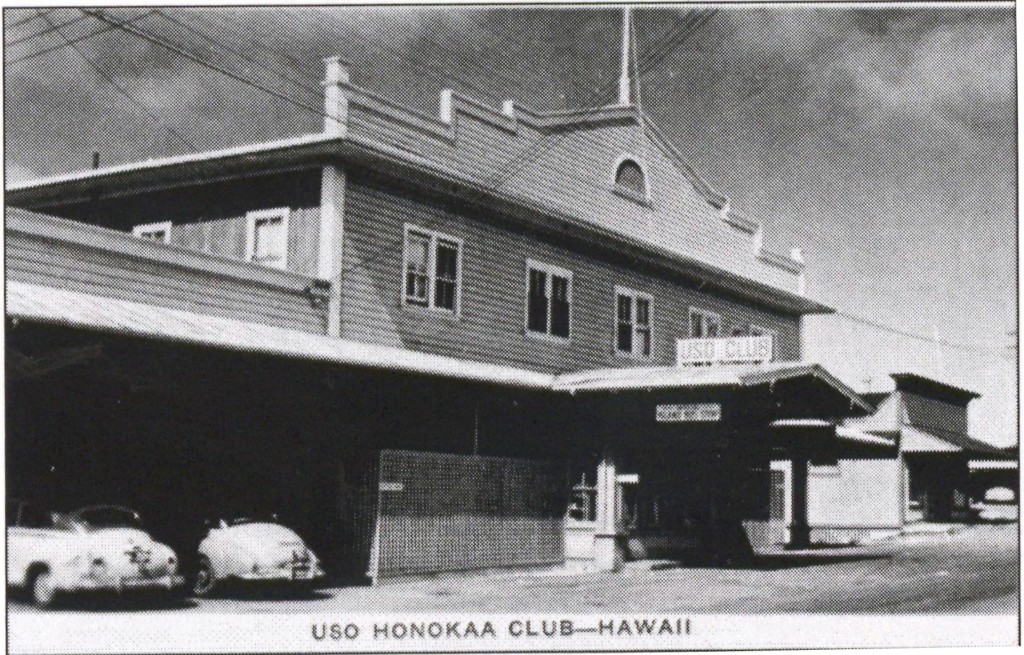
Honokaa USO in 2018 (left) & during WWII (above).
The first USO club in Honoka’a was in a room at the Hawaii County public library on Mamane and the second USO was at the Union Church (now the Methodist Church) also on Mamane. The large Botelho Building on the north side of Mamane became the permanent location of the USO club. The upstairs of the Botelho Building was the USO dance hall. The building is presently used by the Hawaiian Cultural Center of Hamakua and several small businesses. I walked upstairs to check out the dance floor but it looks like it’s been partitioned into offices.
The nearby Hotel Honoka’a Club was also a favorite destination of the Marines. The hotel is just two doors down from the former USO club building and is still a hotel and hostel. There is no bar or restaurant inside the hotel anymore but the bar and former restaurant rooms are still there. The large old restaurant room is used for family events like weddings and graduations.
The Marines were usually dropped off for liberty by the Paradise Cafe at the southwest corner of Lehua and Mamane Streets. The cafe is now Gramma’s Kitchen which serves very good food. That corner has a sign which says “Long Soup Corner”. The story is that the Marines who frequented the Paradise Cafe and could not pronounce “saimin”, a popular noodle dish at the cafe, instead calling it “Long Soup” and so the corner became “Long Soup Corner”.
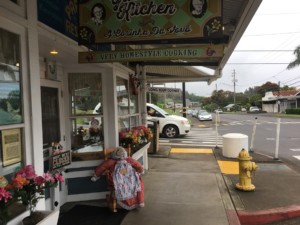
Long Soup Corner Honokaa. Photo credit: Fred Greguras.
Other USOs
The Kona/Kealakekua USO was at the Christ Episcopal Church on Konawaena School Road just east of Highway 11 before you get to Captain Cook. Reverend Kenneth Miller and his family established the USO in Wallace Hall on the grounds of the church. There was a reading and writing area, ping-pong tables, record player to listen to popular music and other activities. The USO offered Thanksgiving and other dinners as well as dances. Wallace Hall is currently being used as a Hawaiian language immersion pre-school. In the early part of WWII, a thatched hut was built on the grounds of the church as a “Little Grass Hut in Kealakekua”, a popular song in the 1930s. Military personnel could have a photo taken under the sign at the grass shack and sent home to let families know they were safe in Hawaii. Servicemen were not allowed to say where they were in letters but the popular song provided a way to communicate through a photograph that bypassed military censorship.
The USO in Hawi was located on the south side of Highway 270 in back of the current Ohana gas station at the intersection of 270 and Highway 250 (Hawi Road), just past the parking lot on a slight hill. This is in the area where the Hawi Farmers Market is held. The hall had various uses; movies, meetings, dances, etc. The building was demolished in the late 1940s or early 1950’s. There are many WWII period buildings on and around the main street of Hawi.
The USOs mentioned above are identified in a July, 1945 Big Island USO brochure. There is a May, 1942 USO brochure that lists USOs at several other rural places (Naalehu, Pahala, Pahoa and Kopoho) but these were before the Marines arrived at Camp Tarawa. The rural clubs were mostly rest and chow stops and operated full time only when needed.
The Downtown Hilo USO on Kamehameha Avenue, which was destroyed in the April, 1946 tsunami, was scheduled to close in the summer, 1946. It was the last WWII period USO open on the Big Island. The Haili Street (Hilo) and Barbara Hall (Waimea) USOs closed in December, 1945. The Mokuola USO (Coconut Island at Hilo) closed in late November, 1945.
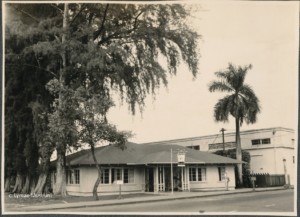
Hilo Downtown club before & after tsunami. Photo credit: Lyman Museum
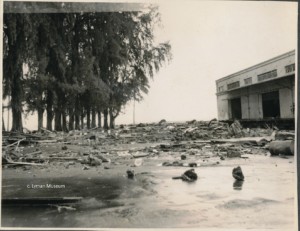
The tradition of Big Island USOs continues today with the USO at the Pohakuloa Training Area along Saddle Road for Marines and soldiers training there. The facility is managed by Army retiree Jody Brissette who hosted a visit by the FMDA reunion attendees in October, 2017. The training area is the site of the artillery camp for Camp Tarawa.
Many thanks to all the great people on the Big Island who helped with this article: Kathy Painton of the FMDA; Eric Page and Gladys Suzuki at the Lyman Museum; Mary Louise Haraguchi at the University of Hawaii-Hilo; Barbara Muffler at the Tsunami Museum; Justin Rajkowski at the Hawaii County Library in Hilo; Jody Brissette of the PTA USO; Eileen (Momi) Naughton at the NHERC in Honokaa; Ross Stephenson of Honokaa; Leslie Taylor Cockerham in Hilo; Dr. A. Stephen Woo of St. Joseph Church; Nancee Cline of Christ Church and Vietnam Veteran Joe Carvalho in Kapaau.
Semper Fidelis!
Fred Greguras is an amateur historian and served as a platoon leader with H/2/5 of the 1st Marine Division in the Vietnam War. He can be reached at fgreguras@hotmail.com.


